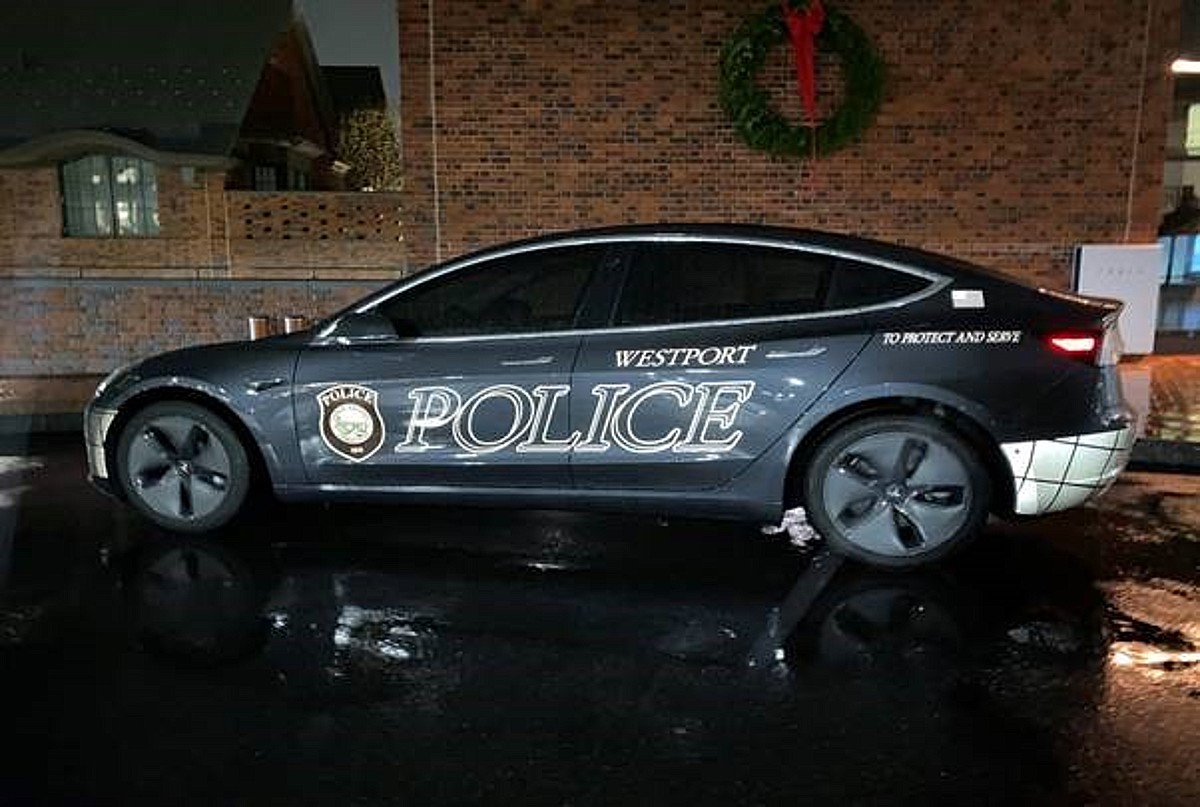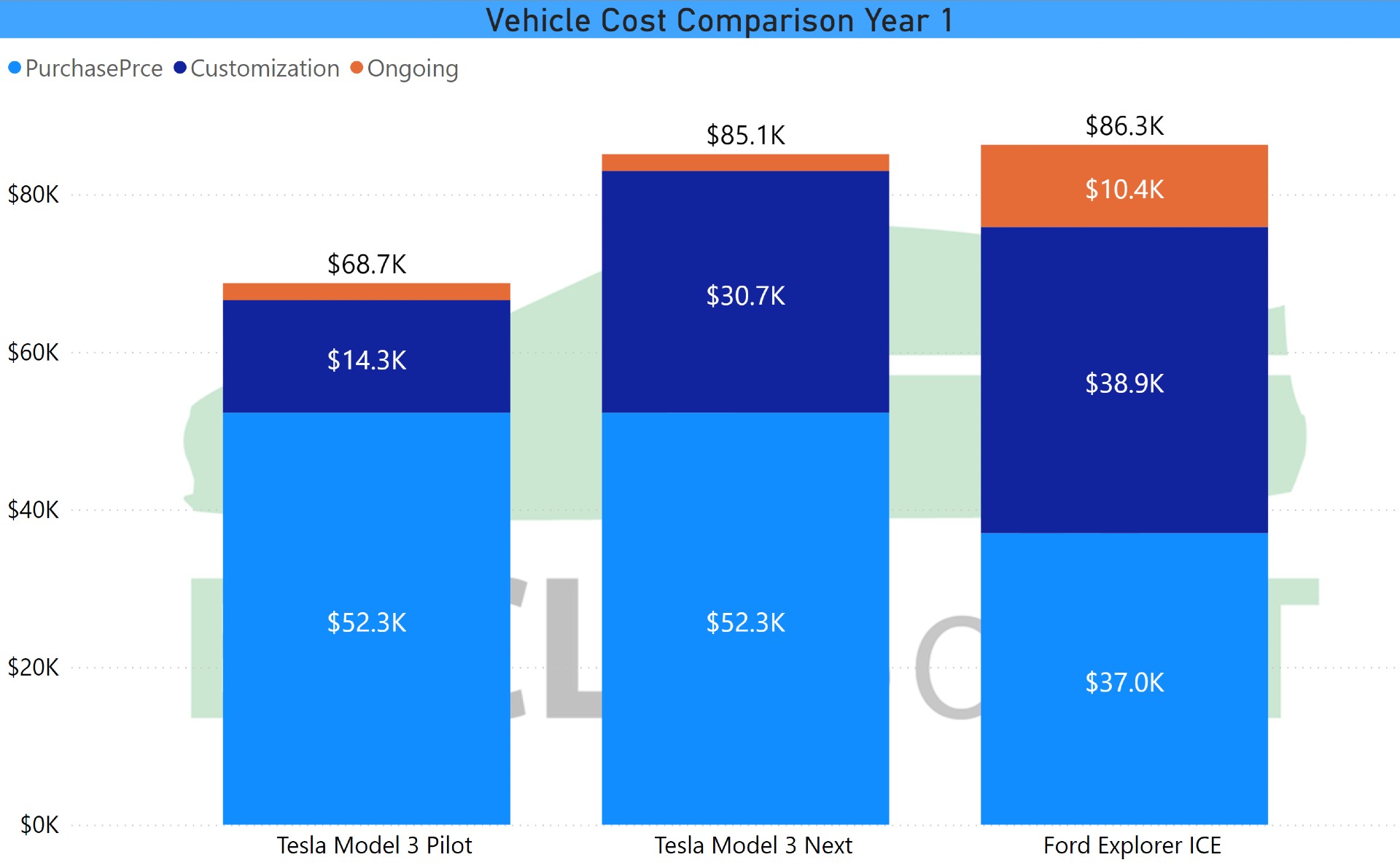

News
Tesla Model 3 used by Police Department reveals massive financial savings
The Westport Police Department in Connecticut has released a new financial analysis that is showing massive savings, as anticipated, after the purchase of a Tesla Model 3 that would be used as a police cruiser. The Police Department reports that it has already helped recoup the purchase price premium and helped save money for the department in its first full year of operation.
After purchasing a Tesla Model 3 in December 2019 and putting it to work in February 2020, Westport PD spokespeople said that the all-electric sedan has already exceeded expectations for performance, cost savings, and environmental benefits. After sparring with the idea of purchasing another Ford Explorer for the police fleet, cost-effectiveness became the big question. There is a $15,300 difference between the Model 3 and the Explorer, but Westport’s PD has no regrets about its decision.
Tesla Model 3 becomes first squad car for Connecticut police department
“The purchase price differential was recouped in the first year due to reduced customization and lower operating costs. All of these have been analyzed in detail,” the department said.
The EV Club of Connecticut completed a vehicle cost comparison analysis after the first year of ownership shows that, despite the additional initial cost of the Model 3, reduced maintenance costs, along with decreased customization needs for the Model 3, gave the department a savings of around $17,600. The ongoing cost of the Model 3 is comparatively less than that of the Ford Explorer based on routine maintenance and fuel costs.

Credit: EV Club of CT
Additionally, the Police Department is also considering purchasing another Model 3 to add to its fleet. After four years of ownership of the “Pilot” Tesla that the department purchased in 2019, the total cost is projected to be $79,400. If another Model 3 is added to the fleet, after four years, it will cost $95,800. The Ford Explorer would be much more expensive, sitting at $120,200.
The Westport Police Department outlined several conclusions after the analysis.
- After four years the Tesla will have saved enough money to buy another Tesla.
- Each EV avoids emission of over 23 tons of CO2 per year and saves $8763 in environmental and health costs.
- There is a $12,582 savings in fuel alone after four years from using electricity to power the vehicle.
- Reduced maintenance. Regenerative braking means that the engine slows the car and recaptures some of the kinetic energy, replenishing the battery and reducing wear on the friction brakes. It is one example of how an EV saves on maintenance. Other examples are no oil changes, spark plugs, transmission, alternator, water pump, or catalytic converter.
- Even during the winter months, the vehicle was able to consistently run two consecutive patrol shifts without needing to be recharged, and there were no operational issues related to charging and battery use.

Credit: EV Club of CT
The Town of Westport audited the financial analysis.
Chief Foti Koskinas, who was a vocal supporter of bringing the vehicle into the fleet, said, “Tesla has been a great partner, including re-coding where necessary. We would not have been able to do things like wire the electronics into the large battery or access the car’s computer without their help.”
Along with the massive cost benefits, the department says the instant torque and performance are key factors in overtaking a suspect’s moving vehicle. This increases the safety of the driver, officer, and other vehicles, as a traffic stop can be completed thanks to the lightning-quick agility of the Model 3 quickly.
Despite the large cost initially, the residents of Westport have been extremely positive. “Feedback from the public has been overwhelmingly positive, Charles Sampson of the Westport PD said. “We’ve have been contacted by at least 50 other police departments – from all over the world – with questions about our experience. I know many of them have gone on to purchase Teslas for their fleets.”
Don’t hesitate to contact us with tips! Email us at tips@teslarati.com, or you can email me directly at joey@teslarati.com.

Elon Musk
Starlink passes 9 million active customers just weeks after hitting 8 million
The milestone highlights the accelerating growth of Starlink, which has now been adding over 20,000 new users per day.

SpaceX’s Starlink satellite internet service has continued its rapid global expansion, surpassing 9 million active customers just weeks after crossing the 8 million mark.
The milestone highlights the accelerating growth of Starlink, which has now been adding over 20,000 new users per day.
9 million customers
In a post on X, SpaceX stated that Starlink now serves over 9 million active users across 155 countries, territories, and markets. The company reached 8 million customers in early November, meaning it added roughly 1 million subscribers in under seven weeks, or about 21,275 new users on average per day.
“Starlink is connecting more than 9M active customers with high-speed internet across 155 countries, territories, and many other markets,” Starlink wrote in a post on its official X account. SpaceX President Gwynne Shotwell also celebrated the milestone on X. “A huge thank you to all of our customers and congrats to the Starlink team for such an incredible product,” she wrote.
That growth rate reflects both rising demand for broadband in underserved regions and Starlink’s expanding satellite constellation, which now includes more than 9,000 low-Earth-orbit satellites designed to deliver high-speed, low-latency internet worldwide.
Starlink’s momentum
Starlink’s momentum has been building up. SpaceX reported 4.6 million Starlink customers in December 2024, followed by 7 million by August 2025, and 8 million customers in November. Independent data also suggests Starlink usage is rising sharply, with Cloudflare reporting that global web traffic from Starlink users more than doubled in 2025, as noted in an Insider report.
Starlink’s momentum is increasingly tied to SpaceX’s broader financial outlook. Elon Musk has said the satellite network is “by far” the company’s largest revenue driver, and reports suggest SpaceX may be positioning itself for an initial public offering as soon as next year, with valuations estimated as high as $1.5 trillion. Musk has also suggested in the past that Starlink could have its own IPO in the future.
News
NVIDIA Director of Robotics: Tesla FSD v14 is the first AI to pass the “Physical Turing Test”
After testing FSD v14, Fan stated that his experience with FSD felt magical at first, but it soon started to feel like a routine.

NVIDIA Director of Robotics Jim Fan has praised Tesla’s Full Self-Driving (Supervised) v14 as the first AI to pass what he described as a “Physical Turing Test.”
After testing FSD v14, Fan stated that his experience with FSD felt magical at first, but it soon started to feel like a routine. And just like smartphones today, removing it now would “actively hurt.”
Jim Fan’s hands-on FSD v14 impressions
Fan, a leading researcher in embodied AI who is currently solving Physical AI at NVIDIA and spearheading the company’s Project GR00T initiative, noted that he actually was late to the Tesla game. He was, however, one of the first to try out FSD v14.
“I was very late to own a Tesla but among the earliest to try out FSD v14. It’s perhaps the first time I experience an AI that passes the Physical Turing Test: after a long day at work, you press a button, lay back, and couldn’t tell if a neural net or a human drove you home,” Fan wrote in a post on X.
Fan added: “Despite knowing exactly how robot learning works, I still find it magical watching the steering wheel turn by itself. First it feels surreal, next it becomes routine. Then, like the smartphone, taking it away actively hurts. This is how humanity gets rewired and glued to god-like technologies.”
The Physical Turing Test
The original Turing Test was conceived by Alan Turing in 1950, and it was aimed at determining if a machine could exhibit behavior that is equivalent to or indistinguishable from a human. By focusing on text-based conversations, the original Turing Test set a high bar for natural language processing and machine learning.
This test has been passed by today’s large language models. However, the capability to converse in a humanlike manner is a completely different challenge from performing real-world problem-solving or physical interactions. Thus, Fan introduced the Physical Turing Test, which challenges AI systems to demonstrate intelligence through physical actions.
Based on Fan’s comments, Tesla has demonstrated these intelligent physical actions with FSD v14. Elon Musk agreed with the NVIDIA executive, stating in a post on X that with FSD v14, “you can sense the sentience maturing.” Musk also praised Tesla AI, calling it the best “real-world AI” today.
News
Tesla AI team burns the Christmas midnight oil by releasing FSD v14.2.2.1
The update was released just a day after FSD v14.2.2 started rolling out to customers.

Tesla is burning the midnight oil this Christmas, with the Tesla AI team quietly rolling out Full Self-Driving (Supervised) v14.2.2.1 just a day after FSD v14.2.2 started rolling out to customers.
Tesla owner shares insights on FSD v14.2.2.1
Longtime Tesla owner and FSD tester @BLKMDL3 shared some insights following several drives with FSD v14.2.2.1 in rainy Los Angeles conditions with standing water and faded lane lines. He reported zero steering hesitation or stutter, confident lane changes, and maneuvers executed with precision that evoked the performance of Tesla’s driverless Robotaxis in Austin.
Parking performance impressed, with most spots nailed perfectly, including tight, sharp turns, in single attempts without shaky steering. One minor offset happened only due to another vehicle that was parked over the line, which FSD accommodated by a few extra inches. In rain that typically erases road markings, FSD visualized lanes and turn lines better than humans, positioning itself flawlessly when entering new streets as well.
“Took it up a dark, wet, and twisty canyon road up and down the hill tonight and it went very well as to be expected. Stayed centered in the lane, kept speed well and gives a confidence inspiring steering feel where it handles these curvy roads better than the majority of human drivers,” the Tesla owner wrote in a post on X.
Tesla’s FSD v14.2.2 update
Just a day before FSD v14.2.2.1’s release, Tesla rolled out FSD v14.2.2, which was focused on smoother real-world performance, better obstacle awareness, and precise end-of-trip routing. According to the update’s release notes, FSD v14.2.2 upgrades the vision encoder neural network with higher resolution features, enhancing detection of emergency vehicles, road obstacles, and human gestures.
New Arrival Options also allowed users to select preferred drop-off styles, such as Parking Lot, Street, Driveway, Parking Garage, or Curbside, with the navigation pin automatically adjusting to the ideal spot. Other refinements include pulling over for emergency vehicles, real-time vision-based detours for blocked roads, improved gate and debris handling, and Speed Profiles for customized driving styles.








